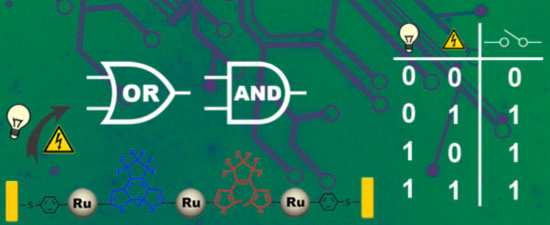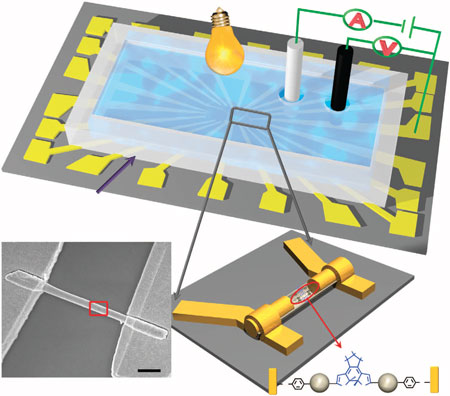| Posted: Jan 08, 2014 | |
Modulating molecular electronics with the help of chemical tailoring |
|
| (Nanowerk Spotlight) External stimuli, such as light, mechanical force, magnetic field, electrical field and electrochemical potential, are all driving forces that can be utilized to modulate the structure or conformation of molecules, and therefore to affect the performance of functional molecular devices. | |
| Inspired by the giant magnetoresistance effect and photoelectric cooperation, a synergy between these external stimuli and corresponding fabrication of multi-addressable molecular transport junctions – essential structures in molecular electronics – may further efficiently advance the field of molecular electronics. | |
| In new work, reported in the January 7, 2014 online edition of Nature Communications ("Orthogonally modulated molecular transport junctions for resettable electronic logic gates"), researchers take advantage of synergetic modulation by multiple external controls to explore multi-modulable molecular devices with the help of chemical tailoring, which have not been addressed so far. | |
| "Chemical tailoring of functional molecules with multi-addressable properties serves as an effective approach to fabricate such molecular devices," Xiaodong Chen, an associate professor in the School of Materials Science & Engineering at Nanyang Technological University, tells Nanowerk. "In order to address this issue, we designed and synthesized a new family of organometallic compounds, targeting multifunctional switching properties addressable with photon and/or electrons." | |
 |
|
| Schematic of a functionalized nanogap device tunable by light and working as a resettable AND-OR logic gate. (Image: Xiaodong Chen, Nanyang Technological University) | |
| The team achieved orthogonally modulated molecular transport junctions via nanogaps functionalized with an organometallic ruthenium fragment-modified dithienylethene (DTE) complex. The addressable and stepwise control of molecular isomerization is achieved by applying the orthogonal optical and electrochemical stimuli at varying degrees. That way, the controllable switching of conductivity between two distinct states can be repeatedly and reversibly obtained. | |
| The successive structural rearrangements of the incorporated molecules within the nanogaps are all based on rational molecular design. The DTE unit that undergoes the isomerization between a π-conjugated closed state and a non-conjugated open state determines the conductive state of the nanodevice. | |
| Meanwhile, the ruthenium moieties properly modulate electronic coupling between this DTE moiety and gold nanoelectrodes to avoid one-way switching in a similar complex as previously reported ("Photo-modulable molecular transport junctions based on organometallic molecular wires "), and also guarantee the low potential electro-triggered metal-promoted electrochemical cyclization that allows stable Au-S bond connection between the functional molecules and two nanoelectrodes. | |
| Moreover, the unique electronic structure of the longer molecule combined with two DTE units offers the stepwise control. Compared to other logic gates based on chemical systems, these organometallic molecule-based devices can be simply reset by visible light, ensuring a cycled set-reset operation. | |
 |
|
| Diagram of the functionalized nanogap devices. Inset: SEM image of a device fabricated by on-wire lithography-generated nanowire (scale bar: 1 µm). (Reprinted with permission from Nature Publishing Group) | |
| These photo/electro-cooperative molecular transport junctions, which constitute the first molecular nanodevices tuned by orthogonal light irradiation and electrochemical stimuli, can be applied as resettable electronic logic gates for OR and AND-OR Boolean computing. | |
| "This proof-of-concept of logic gate demonstrated in our work provides a solid platform for the development of multifunctional molecular devices by rational chemical design after optimizing fabrication and operative conditions," notes Chen. | |
| "Based on the rapid development of synthetic chemistry, we can build various functional molecules to fulfill the requirements of advanced nanocircuits," he continues. "However, the stability and response time of such molecular devices are still unable to match the performance of traditional semiconductor materials. Therefore, there is much room for improvements in the optimization of device fabrication and stable assembly of functional molecules to fit the future application of complex logic computing." | |
 By
Michael
Berger
– Michael is author of three books by the Royal Society of Chemistry:
Nano-Society: Pushing the Boundaries of Technology,
Nanotechnology: The Future is Tiny, and
Nanoengineering: The Skills and Tools Making Technology Invisible
Copyright ©
Nanowerk LLC
By
Michael
Berger
– Michael is author of three books by the Royal Society of Chemistry:
Nano-Society: Pushing the Boundaries of Technology,
Nanotechnology: The Future is Tiny, and
Nanoengineering: The Skills and Tools Making Technology Invisible
Copyright ©
Nanowerk LLC
|
|
|
Become a Spotlight guest author! Join our large and growing group of guest contributors. Have you just published a scientific paper or have other exciting developments to share with the nanotechnology community? Here is how to publish on nanowerk.com. |
|
